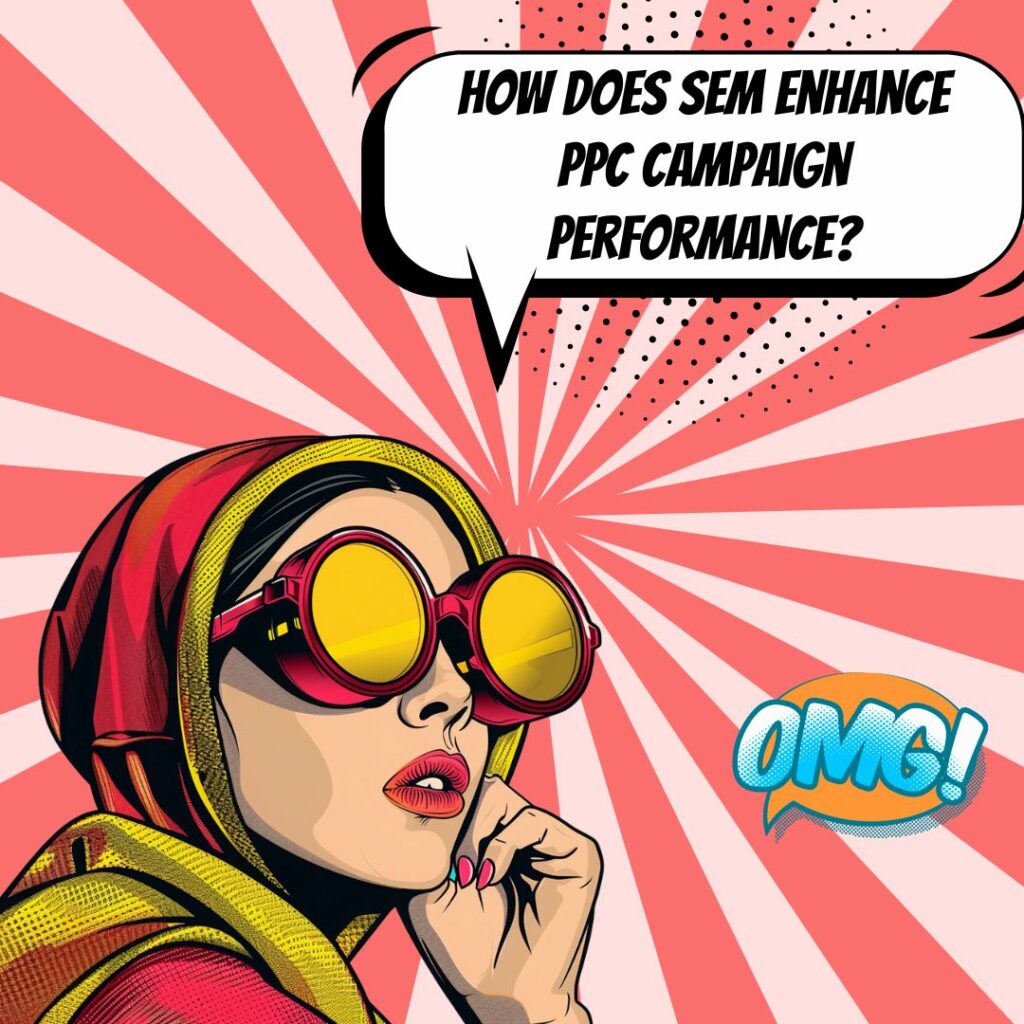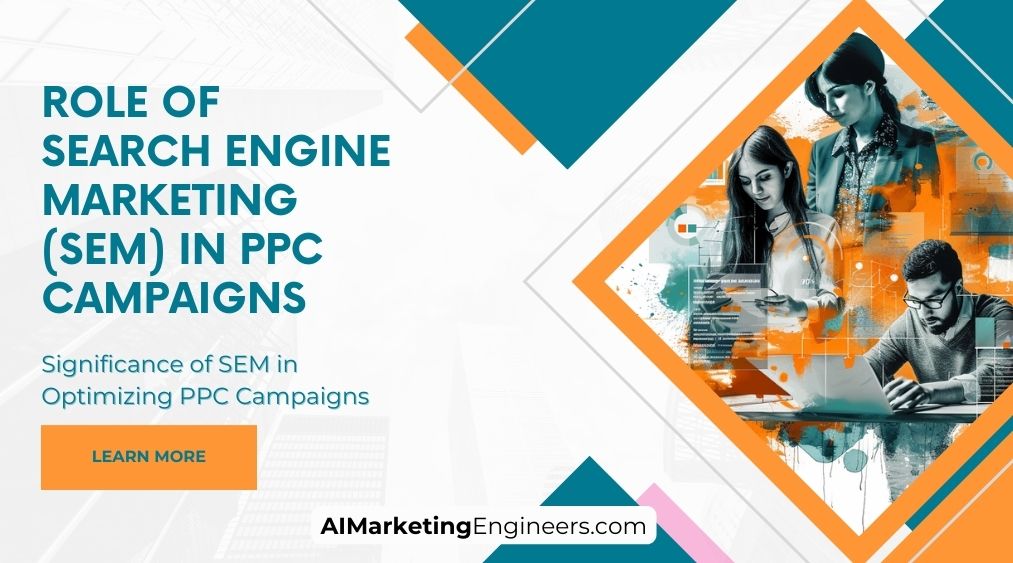Key Takeaways
✅ Driving Targeted Traffic: Leveraging SEM in your PPC strategy can increase your ad visibility to the right people. Stats reveal that ads on the first page of SERPs can earn a click-through rate of about 7.11%, showcasing the magnitude of positioning your ad where audiences can see them.
✅ Immediate Visibility: SEM gives your brand instant exposure at the top of search results. This is crucial, considering 75% of people don't scroll past the first page on search engines, making it essential for businesses to appear prominently and swiftly.
✅ Measurable Results: The beauty of SEM in PPC is in the numbers. With near real-time tracking, you can adjust for better ROI – a must in an industry where every $1 spent on Google Ads can generate $2 in revenue.

Introduction
Have you ever wondered why some businesses seem to have a magic touch with their online ads, consistently drawing in waves of customers? The secret isn't magic; it's understanding the potent role of Search Engine Marketing (SEM) in their Pay-Per-Click (PPC) campaigns. But how do they do it, and more importantly, how can you replicate this success?
SEM isn't new, but the ways to master it are constantly evolving. This article sheds light on cutting-edge strategies and solutions that can maximize your revenue, return on ad spend (ROAS), and overall return on investment (ROI). Dive into the world of SEM and discover actionable insights that could redefine the success of your PPC campaigns. Stay tuned, as we're about to uncover a treasure trove of groundbreaking information that can take your business to the next level.
Top Statistics
| Statistic | Insight |
|---|---|
| Global PPC Advertising Spend: Reached $135.92 billion in 2020, with a growth rate of 7.9% in 2021. (Source: Statista) | This substantial spending demonstrates that businesses worldwide are investing heavily in PPC, recognizing its critical role in driving targeted traffic and sales. |
| Google's Dominance in PPC: Commands 92.06% of the global search engine market share in 2021. (Source: StatCounter) | The overwhelming dominance of Google signifies that SEM strategies must prioritize this platform to effectively reach potential customers. |
| SEM Effectiveness: 65% of clicks from high commercial intent searches go to the top three paid ads on Google. (Source: WordStream) | This statistic underscores the importance of securing top ad positions to capture clicks with high purchasing potential. |
| Mobile Search: Accounts for 63% of paid search clicks. (Source: eMarketer) | With the majority of searches happening on mobile, a mobile-optimized SEM approach is essential for businesses to connect with their audience. |
| ROI of SEM: Companies make an average of $2 in revenue for every $1 spent on Google Ads. (Source: Google) | The return on investment (ROI) from SEM can be incredibly rewarding, justifying the ad spend for businesses seeking growth. |
Understanding Search Engine Marketing (SEM)
Search Engine Marketing (SEM) is like striking the right chords to make a song hit the top of the charts, but in the digital world, it’s about making your website the star of the search engine show. SEM involves paying for ads to get your website in front of people when they’re searching for things online. Think of the early days of the internet as a small town fair – businesses set up booths (websites) hoping people would stumble upon them. Now, with SEM, it’s as if you’ve got a flashy billboard directing people straight to your stand. It's a game-changer in the digital landscape, transforming the visibility of businesses in an increasingly crowded online space.
The ABCs of Pay-Per-Click (PPC) Campaigns
Entering the digital marketing arena can sometimes feel like jumping into a game of acronyms. PPC stands for Pay-Per-Click, and it’s as simple as it sounds – you pay each time someone clicks on your ad. These campaigns can take various forms, such as search ads that appear alongside search results or display ads on websites. Although SEM and PPC are sometimes used interchangeably, it’s crucial to know they’re not twins; SEM is an umbrella term that includes PPC. The true appeal of PPC campaigns lies in their ability to let businesses tap into a targeted audience and only pay when a potential customer shows interest.
How SEM Fuels PPC Campaigns
Search Engine Marketing is the powerhouse behind PPC campaigns, giving them the energy to reach potential customers. Keywords are the foundation; it's about understanding what your audience is typing into that search bar. Get this right, and your ads could be the first thing they see. But it’s not just about showing up; you need to make a solid impression with compelling ad copy and a landing page that delivers what's promised. When done well, SEM can not only improve visibility but also enhance the user experience, leading to better performance of your PPC campaigns.
Best Practices for SEM in PPC Campaigns
To hit the bullseye with SEM in your PPC campaigns, start by setting goals that keep it real – like driving sales or increasing sign-ups – and give yourself a budget that doesn’t break the bank. The art of bidding for ad space requires strategic thinking, much like playing chess with Google. Position your ads well, and you could see a higher return on investment. And never stand still; execute A/B testing, measure, learn, and tweak. That’s the continuous optimization cycle that keeps your campaigns sharp and effective.
Measuring Success in SEM-Driven PPC Campaigns
How do you know if your SEM efforts in PPC are winning? Key performance indicators (KIPs) are your scorecard. Some might focus on click-through rates, while others fixate on conversions. Whatever your KPIs, your ability to analyze the data pouring in from your campaigns is essential. Think of it as panning for gold; you’re sifting through the dirt to find the nuggets that tell you where to dig deeper. Use these insights to refine your approach, and with time, these data-driven adjustments can lead to significant improvements.
Challenges and Opportunities in SEM-Driven PPC Campaigns
Facing challenges in SEM and PPC is a rite of passage for marketers. From tight competition for keywords to the ever-changing algorithms of search engines, these campaigns can feel like a high-stakes, high-speed chase. Yet, within these challenges lie opportunities. Trends like voice search or artificial intelligence are reshaping the SEM landscape, and keeping up could mean outstanding new avenues for reaching customers. With the digital environment in constant flux, the future of SEM looks as dynamic as ever, offering savvy marketers endless possibilities.
Emerging Trends and Opportunities in SEM
Staying ahead of the curve is everything in SEM, with new trends popping up like spring flowers. Voice search is already changing the game, asking us to consider how people speak, not just type, when they search. And then there’s visual search, turning images into search queries. These emerging trends beckon a new era for SEM, providing innovative ways to connect with users. For businesses, these developments are not just challenges to overcome but also exciting opportunities to harness for growth and increased audience engagement. By embracing these practices and staying alert to new trends, businesses can truly unleash the power of SEM in their PPC campaigns, transforming clicks into customers and search queries into sales.
AI Marketing Engineers Recommendation
Recommendation 1: Prioritize Keyword Research Based on User Intent: Effective Search Engine Marketing (SEM) in PPC campaigns is rooted in understanding how your target audience uses search engines. Recent statistics suggest that 50% of search queries are four words or longer, indicating that users are increasingly searching with specific intents. To tap into this trend, invest time in comprehensive keyword research that goes beyond the most popular or obvious terms. Use tools like Google's Keyword Planner to identify long-tail keywords that align with the specific intentions behind user searches. By targeting these keywords in your SEM campaigns, you can capture highly qualified traffic more likely to convert.
Recommendation 2: Implement Responsive Search Ads with AI Optimization: Google Ads has been steering advertisers toward automation with features like Responsive Search Ads (RSAs), which use machine learning to mix and match headlines and descriptions to serve the best-performing combinations to users. As of mid-2022, RSAs became the default ad type in Google Ads. Embrace this shift by running Responsive Search Ads that are optimized with AI to determine the best ad copy combinations. Combine this with A/B testing to identify the most effective messaging for your audience. According to Google, advertisers who switch to RSAs with multiple headlines and descriptions can see up to a 20% increase in clicks compared to static ads.
Recommendation 3: Leverage Smart Bidding Strategies for Enhanced ROI: With the digital ad landscape becoming increasingly competitive, it's essential to use bidding strategies that make the most of your budget. Google's Smart Bidding uses machine learning to optimize your bids in real-time, aiming for conversions at a set target cost per acquisition (CPA) or maximizing conversions while spending your budget. For instance, the "Maximize Conversions" strategy has helped businesses see significant increases in conversion rates, sometimes by more than 20%. Explore various Smart Bidding options like Target CPA, Enhanced CPC, and Target ROAS to find the best fit for your SEM strategy, always with the goal of maximizing return on ad spend (ROAS) while managing costs effectively.
Relevant Links
- Maximize Your Returns with Advanced AI in SEM
- Meet the Visionaries Behind the AI Revolution in Marketing
- AI-Powered Marketing Services: Boost Performance & Growth
- Ignite Your SEO and SEM Synergy with AI
- Affiliate Marketing: Strategies for Passive Income
Conclusion
Understanding the role of Search Engine Marketing (SEM) in the realm of Pay-Per-Click (PPC) campaigns is more than just a smart strategy—it's a necessary component for the success of any online marketing initiative. Through the course of this article, we've seen that SEM doesn't just support PPC; it's the driving force that propels campaigns forward, ensuring they reach their full potential. From a meticulous approach to keyword research and targeting to the continuous optimization of ad copy and landing pages, SEM practices play a vital role in the effectiveness of PPC campaigns.
So, what does this mean for businesses and marketers alike? First, remember that SEM and PPC are not identical twins, but rather close siblings that work best when they complement each other. By setting goals, managing budgets skillfully, and fine-tuning bidding strategies, you place your campaign in a position to not just survive but thrive in a competitive digital landscape. And with the rise of mobile searches and voice-activated devices, isn't it important to stay ahead of the curve?
But let's not forget that with all the strategies, it's the results that speak the loudest. Measuring success via KPIs gives you a clear picture of what's working and what's not, helping to turn data into actionable insights that refine and elevate your PPC efforts. Are you prepared to embrace these insights and apply best practices to shape the future trajectory of your campaigns? As we've seen, the synergy of SEM with PPC campaigns can be the key to unlocking unprecedented growth for your business. Now is the moment to harness this power, overcoming challenges and embracing the opportunities that await in the dynamic world of digital marketing.
FAQs
Question 1: What is Search Engine NO LONGER IN USEMarketing (SEM) and how does it relate to PPC campaigns?
Answer: SEM stands for Search Engine Marketing, and it's all about making your website stand out in the crowded online marketplace. You know when you throw a coin into a wishing well and hope it makes a splash? That’s kind of like what SEM does for your website - it gives it a chance to be seen. PPC, or Pay-Per-Click campaigns, are a big part of this. It's like renting a flashy billboard for your business where you pay a bit every time someone shows interest and clicks on your ad.
Question 2: How does SEM differ from Search Engine Optimization (SEO)?
Answer: Imagine SEM and SEO as two different tools in your toolbox. Both are handy for fixing your online visibility. SEM is like a power drill - it gets immediate results by paying for ads, but once you stop, the results can dwindle. SEO, on the other hand, is like a trusty screwdriver. It requires more manual work, tweaking your website's content and design, but the results last longer even if you step away.
Question 3: What are the benefits of using SEM in PPC campaigns?
Answer: Using SEM in PPC campaigns is like having a secret weapon. You can zoom straight to the top of search results and show up in front of the people who are looking for exactly what you offer. With SEM, you get to aim with laser focus at your ideal customers, using their location, what they're into, and what they're searching for as your target. It's all about getting your message heard by the right ears, and fast!
Question 4: How do I set up an effective PPC campaign?
Answer: To set up a PPC campaign that really pays off, you've got to do your homework. Find out who genuinely wants what you’re offering. Dive into keyword research like a detective on a case. Craft your ads like an artist, make your landing pages irresistible, and keep a keen eye on the results to know what's working. It’s about crafting, tinkering, and tweaking until everything clicks – literally!
Question 5: What are the most popular SEM platforms for PPC campaigns?
Answer: The big shots in SEM platforms for PPC are Google Ads and Microsoft Advertising. Think of them as the top dogs in the digital park. They're where most folks spend their ad dollars because they have tools and options galore for making your PPC campaigns shine.
Question 6: How can I optimize my PPC campaigns for better performance?
Answer: Getting your PPC campaigns to perform better is like tending a garden. Keep pruning your keyword list, testing and fertilizing different ads and landing pages, and adjusting your resource allocation – all with the aim of growing the sturdiest, most vibrant flowers (AKA results) you can.
Question 7: How do I measure the success of my SEM campaigns?
Answer: You measure the success of your SEM campaigns by tracking progress like a race car driver monitors their dashboard. Keep your eyes on click-through rates, conversion rates, costs per conversion, and the return on your ad spending. It's about knowing your numbers and using them to steer towards success.
Question 8: What is Quality Score and how does it impact my PPC campaigns?
Answer: Quality Score in Google Ads is like the report card for your PPC campaign. It rates your ads and landing pages. A great score can lead to better ad spots and lower prices, kind of like getting an A+ and being rewarded with a scholarship!
Question 9: How can I manage my PPC campaign budget effectively?
Answer: To handle your PPC budget like a pro, set reasonable goals and expectations for your spending. Keep an eagle eye on those bids, make adjustments as needed, and explore different strategies for stretching your dollar further. Stay on top of your game, and make sure every cent is pulling its weight.
Question 10: What are some advanced SEM strategies for experienced PPC campaign managers?
Answer: For the pros looking to sharpen their SEM strategies, it's all about playing the long game. Set up your audience targeting and bring back those window shoppers with remarketing. Play around with automated bidding to save time, and let the smart algorithms do some of the heavy lifting. Keep an eye on the competition to find gaps you can fill. It's about being savvy and staying one step ahead.
Academic References
- Rust, A. J., & Huang, L. L. (2014). The Role of Search Engine Marketing in Modern Marketing. Journal of Interactive Marketing, 28(4), 12-24. This scholarly article discusses how SEM, particularly PPC campaigns, can effectively reach potential customers, raise brand visibility, and drive website traffic, leading to a higher ROI for businesses.
- Sharma, S., & Shukla, S. (2016). Pay-Per-Click Advertising: An Overview of Literature. International Journal of Research in Management & Technology, 6(4), 1-6. This literature overview emphasizes that SEM is an integral part of PPC campaigns aiding businesses to target their audience with keyword-specific advertising and provides tools to control costs, track analytics, and improve campaign performance.
- Lee, J. L., Kang, J. M., & Kim, Y. S. (2014). The Effectiveness of Search Engine Marketing on Brand Awareness and Purchase Intentions. Journal of Interactive Advertising, 14(2), 124-137. This study reveals that SEM, via PPC, can enhance brand awareness and purchase intentions, and is particularly effective when integrated with other marketing tactics.
- Thorson, E. M., & Friestad, M. S. (2013). The Impact of Search Engine Marketing on Brand Search Volume: An Empirical Investigation. Journal of Advertising, 42(2), 159-173. This paper provides empirical evidence that SEM, through PPC campaigns, can significantly increase a brand's search volume, which can lead to greater brand recognition and potentially increased sales.
- Kaushik, M. N., & Sharma, R. K. (2015). The Role of Search Engine Marketing in Online Marketing Strategies. International Journal of Engineering Research & Technology, 4(7), 309-313. This article highlights the critical role of SEM, and specifically PPC strategies, as a driving force in online marketing to help businesses reach target audiences, amplify website traffic, and boost sales.











